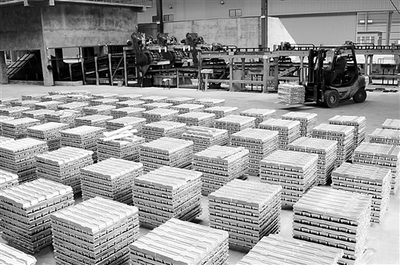
ã€China Aluminum Network】 Furnace is a commonly used equipment for smelting reclaimed aluminum alloys. Its advantages are low investment, easy operation, and high metal recovery rate, but its disadvantages are low production capacity, short life and unstable components, and it is difficult to react with large reflections. Furnace compared. Furnaces vary in form, and cast iron and graphite crucibles are commonly used. When the crucible furnace is in use, the furnace body is fixed on a pan stand that is masonry with a refractory material, and the lower part and the periphery of the crucible furnace are combustion chambers. When using a larger crucible furnace, the bottom of the furnace body cannot be aerialized because of the self-weight problem of the crucible furnace, and it should fall on a stable refractory material, especially a large-scale cast iron crucible, which will deform the furnace body at high temperatures. And affect its life.
Furnace fuel has strong adaptability and can be used for coal, coke, gas, etc. The choice of fuel is relatively large. When fuel or gas is used as a fuel, there is a nozzle under the helium, sprayed into the fuel and the air is burned and heated. This is a fuel enthalpy or gas stove. When electrically heated, a resistive heating element (resistor wire or silicon carbide rod) is arranged around the crucible, ie, a resistance crucible. Furnaces using fuel generally heat up quickly, but their temperature control cannot be very strict. Resistance heating furnace heating temperature is relatively slow, when the heating wire up to 900, silicon carbide rods up to 1200, lower than the temperature of the fuel furnace, while its expensive equipment, high power consumption and high cost of smelting. However, its production environment and working conditions are good, and the melting temperature can be accurately controlled. It is suitable for melting aluminum and magnesium alloys.
The external heat source first heats the crucible, heats the crucible, and then transfers heat to the metal charge or melt inside the crucible. According to this heat transfer characteristic, the crucible furnace is an external heat melting furnace for improving thermal efficiency. The crucibles are made in small form with a higher diameter to increase the contact area of ​​the metal with the crucible wall. In this way, the contact area between the molten liquid metal and the external atmosphere is relatively small, which can reduce oxidation and inhalation of the metal, and is beneficial to the metal. In the smelting of aluminum alloys, there are two types of crucibles, one being graphite crucibles with high strength and refractoriness and the other being cast iron crucibles.
(1) Graphite crucible: Graphite crucible is produced and supplied by a professional refractory factory. There are many sizes and capacities of crucibles. The number of crucibles is the number of kilograms of melted copper alloys. For example, 50 crucibles can melt 50 kg of copper. Its capacity should be divided by a factor of 0.4. Graphite crucibles can be used many times, but the overall life expectancy is short, and as the use of time increases, the thermal conductivity of crucibles decreases, affecting the thermal efficiency and production efficiency.
(2) cast iron crucible furnace: due to the lower melting temperature of aluminum alloy, mostly at 700 - 800 °C, so a large number of metal crucibles, commonly used cast iron crucible furnace. Ordinary cast iron crucibles are low in price, high in strength, and good in thermal conductivity. They are widely used in production, but their service life is short, and they are frequently replaced during production. To increase the life of cast iron crucibles, crucibles of heat-resistant cast iron or heat-resistant steel containing nickel, chromium, or aluminum may also be used to increase their service life. The capacity of cast iron crucibles used for melting aluminum alloys is mostly 30-250 kg, generally not exceeding 300 kg, and large-capacity up to 500 kg.
In order to prevent the iron in the crucible from infiltrating into the aluminum liquid during the melting process, and also to protect the crucible, the crucible must be sprayed with a protective coating on the crucible wall before use. The paint condition of the crucible furnace can be found in related materials. The large crucible furnace is mostly stationary. After the smelting process is completed, the pouring spoon can be poured from the crucible and the melt can be poured. For large castings, the crucible can be hung out and poured. Many small and medium-sized resistance furnaces have a tilting mechanism to dump the solution in the crucible.
At present, furnaces are being developed in the direction of mechanization of large-scale and control systems. Large-scale furnaces can be tilted, and the tilting furnace body can be poured out of the melt.
Structural Insulated Panels are high performance thermal efficient composite panels which consist of a sandwich of two layers of structural board with an insulating layer of foam in between for walls, roofs and floors in new residential and commercial buildings.

1. Architectural Benefits
High quality construction method.
Comfortably warm, clean, and quiet.
2. Cost Benefits
Equal or lower first costs.
Lower long term operating costs.
Incentives available from utility service provider for energy efficient design.
Lower maintenance costs for you.
3. Construction Process Benefits
Easy to construct, with short learning curve.
60% shorter construction time
Quick turnaround time for greater satisfaction.
Increased builders production capacity.
4. Environmental Benefits
50% less framing lumber.
50% more energy efficient.
Requires less room at building site (less site disturbance).
Less construction waste.
structural insulated panels are prefabricated systems used primarily for walls and roofs. SIPs employ composite materials, reduce waste through modular construction methods, achieve high insulation values, and may be used instead of many conventional building methods.
Structural Insulated Panels
Structural Insulated Panels,Structural Insulated Wall Panels,Structural Insulated Roof Panels,Insulated Building Panels
Dalian Quacent New Building Materials Co.,Ltd. , https://www.quacenthomes.com